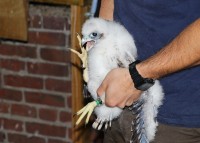Lawrence Peregrines: Day 32
June 5, 2019 in Near the Clock Tower
The peregrines started off the morning with a few clouds, wind from the S at 9MPH, and temp at 59F. The day ahead calls for mostly cloudy skies with isolated showers this morning, then scattered showers and thunderstorms this afternoon. Highs in the mid 70s. Southwest winds 5 to 10 mph with gusts up to 20 mph. Tonight, cloudy with a chance of showers and thunderstorms in the evening, then thunderstorms and showers likely after midnight. Areas of fog after midnight. Some thunderstorms may produce gusty winds and heavy rainfall. Lows in the lower 60s. Southwest winds 5 to 10 mph.
 The webcam was down for most of the day. Had nice looks at the female and chicks from outside late afternoon. At one point, the female became more alert to a nearby distraction, began vocalizing, and then launched into flight. Overall by day 32, the patches of remaining down feathers are becoming restricted to the base of the legs, parts of the wings, and perhaps parts of the back, as well as the crown. They are also becoming increasingly vocal and active around the nest area, to the extent that the adults rarely visit except to drop off food for them. The oldest of the three, has the darkest back and fewest remaining bits of down on its back and elsewhere. Over the next few days, the wing flapping, and jumping around the box will increase substantially!
The webcam was down for most of the day. Had nice looks at the female and chicks from outside late afternoon. At one point, the female became more alert to a nearby distraction, began vocalizing, and then launched into flight. Overall by day 32, the patches of remaining down feathers are becoming restricted to the base of the legs, parts of the wings, and perhaps parts of the back, as well as the crown. They are also becoming increasingly vocal and active around the nest area, to the extent that the adults rarely visit except to drop off food for them. The oldest of the three, has the darkest back and fewest remaining bits of down on its back and elsewhere. Over the next few days, the wing flapping, and jumping around the box will increase substantially!
The calling for food, by the chicks, increases in strength as the young grow, and this call, develops into a wail similar to the parent’s call; and this call can be heard from quite a distance, perhaps even a mile away. Parental creaking noises on arrival with food, increases as the young mature. In the second half of the overall 40 day nestling period, a youngster consumes quite large amounts of food and its intake eventually exceeds that of an adult of the same sex!
Literature cited:
Ratcliffe, D. 1993. The Peregrine Falcon. 2nd ed. Carlton, England: T. and A. D. Poyser.
The Canadian Peregrine Foundation, Peregrine Falcon Development – Age Guide; http://www.peregrine-foundation.ca/info/ageguide.html











